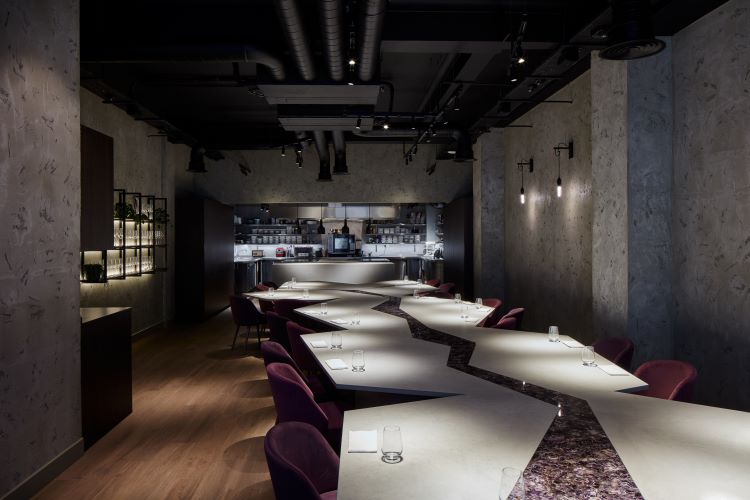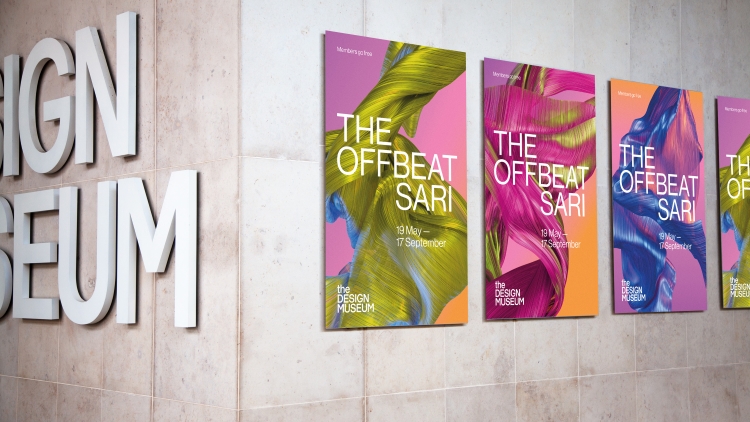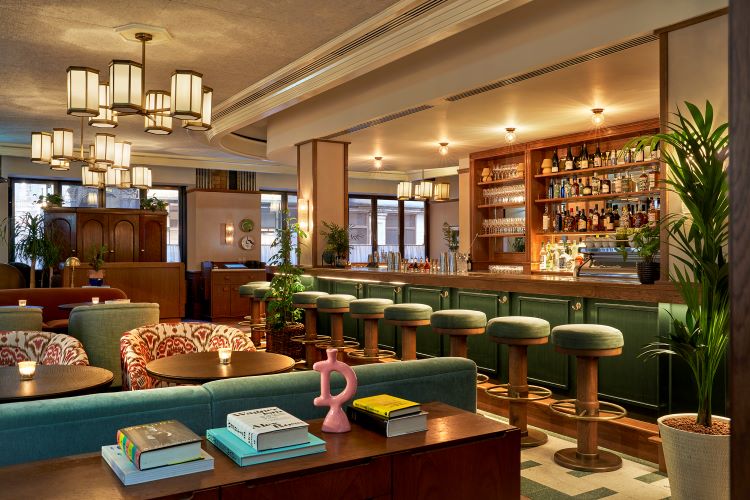Interiors Inspiration: Design Week’s favourite hospitality and retail interiors
From a theatrical dining space in London to a grand rug showroom in Stockholm, here are our favourite recent interior design projects.
Noma Kyoto Pop Up, by OEO Studio

Danish design studio OEO has designed the interiors for a Noma Kyoto restaurant pop-up within Ace Hotel Kyoto. The pop-up comprises a main dining area with a high ceiling and outdoor views, a second dining space and two private dining rooms.
OEO Studio specialise in merging Nordic and Japanese culture through design. Taking inspiration from Kyoto’s rich history in crafts, the studio opted to work with local creatives to source crafted materials, from ceramics and tatamis to textiles, bamboo and wood. OEO sought to use them in unorthodox ways throughout the space, employing coloured tatami mats as acoustic wall screens and room dividers, and hanging architectural bamboo structures from the ceiling to help divide the space.
A standout feature is the illusion of an underwater kelp garden in the main dining space, co-created with a Tenugui (Japanese fabric) maker and Copenhagen-based Natural Material Studio. The marine theme continues through bespoke pendant lights by Jonas Edvard made from compressed seaweeds. Furniture and lighting pieces, such as the cabinets by Time & Style, wall lamps by Santa & Cole and Stella Works and a minimal AYA furniture collection by OEO, seek to highlight the similarities and differences between Japanese and Scandinavian design.
Nordic Knots, by Studio Giancarlo Valle

In an old cinema in Stockholm’s design district Swedish rug brand Nordic Knots has set up its flagship store. Seeking to reveal the grandeur of Swedish design through a New York City lens – as this is where the idea for the brand was born – Nordic Knots reached out to Studio Giancarlo Valle to create an interior space respectful of existing architecture while introducing new, layered textures and neutral-warm hues.
Terrazzo flooring meets the green marbled walls at a checkerboard skirting border, while brushed stainless steel tables sit against warm walnut and oak cabinetry. What was once the theatre foyer is now the main gallery space, though the original grand Carrera staircase has been retained. Nordic Knots latest collections are revealed on a display of rotating installations, accented by lighting from Mexican designer Carlos H. Matos.
A small coffee bar was included to encourage people to dwell in the main gallery space before being led into the Nordic Knots Sample Bar. Its full collection of rugs will live in this “playful and inventive area”, where visitors can “experience the quality, tactility and craftsmanship of each piece”, according to the studio.
Amethyst, by Sahand and Laura Jalali

Seeking a theatrical yet minimal look and feel for their new restaurant in Mayfair, London, Amethyst owners Sahand and Laura Jalali designed a dining experience centred around a vast amethyst and quartz table and an open kitchen. The overarching concept was to design a “raw” space that would not distract from the chef Carlo Scotto’s culinary experience, according to Sahand Jalali.
The irregular, geometric table takes up much of the floor space in the main dining area. It seats 21 people and, although it is semi-communal, it still allows diners an individual experience. While the dining area is dimly lit, the open kitchen – which sits at the head of the table – is bathed in light, comparable to a stage in a theatre. In an effort to bring diners into the kitchen and eliminate any harsh lines, Jalali says they used the same material for the base of the table and the kitchen pass.
Despite its location, Jalali says it was designed to be very “un-Mayfair”, instead leaning into muted tones and finished to create a space that is “raw”. For the concrete walls, a blue-grey tone was avoided in favour of a more neutral shade with green undertones, which was achieved by experimenting with different additives.
The space is decorated minimally with unobtrusive lighting housed by black-edged shelves. The minimal lighting helps to highlight the “textured finish” of the concrete walls, so it is not mistaken for wallpaper, Jalali explains. Below is an intimate space called the Wine Cellar, which follows the same minimal design principles. One of the only decorative elements in this space is a commissioned art piece from Romania, made with the same amethyst as the upstairs table and additions of green quartz.
Socca, by Fabled Studio

Fabled Studio has unveiled its most recent project: a culinary experience which aims to bring the French Riviera to Mayfair, London. The restaurant is housed by a Grade II listed building, with interiors that draw inspiration from French institutions such as La Columbe d’Or hotel and restaurant and Villa Santo Sospir.
Diners encounter a sculpted rattan greeter and desk framed by sky blue awnings upon entry, before entering the Grand Salon. At the heart of the space, there is a Breccia Violetta raw marble bar with embossed leather detailing and bronze metalwork and table lamps, sitting beneath two grand pendant lights. The walls in this main space are lined with warm timber panelling, chosen to complement the deep navy leather and patterned fabric banquettes and booths.
The room has also been styled with a curated selection of artworks, chosen to pay homage to La Columbe d’Or, and its strong connection with local artists’ pieces. The studio also commissioned artists, taking inspiration from Jean Cocteau and Raoul Dufy’s painting of Nice.
Tucked away at the back of the space is Le Bar, lined with timber to echo the walls and surrounded by oxblood leather bar stools. Going further still, diners will come to the Petit Salon, a private dining room wrapped in a layered mural. This smaller dining space features olive green, leather banquettes and pleated silk wall lights, which seek to add a glow to the room.
Fabled sought to continue the “residential ambience” down to the bathrooms, painting the women’s in pink and yellow hues offset with striped wall coverings, using tones of green in a similar fashion in the men’s room. The women’s bathroom also includes silver leaf mirrors which sit above Rossa Luana marble vanities, accented with bronze hardware.
Garden of Eden, by Print Station and CMYUK

New vegan eatery, The Garden of Eden, situated on the first floor of flagship luxury department store Daniels in Royal Windsor, aims to challenge misconceptions surrounding vegan food with a space that would appeal to families with younger children. Wide-format digital print and creative solutions provider Print Station collaborated with CMYUK on the interiors.
Print Station was given full control of the restaurant’s creative concept, from the logo to the interiors. Print Station director Rajan Chonkaria says that they aimed to design “a contemporary, uplifting space” with “a gentle subtlety about it”, avoiding anything “too hectic or overbearing”. To keep with the vegan ethos, Print Station wanted to use eco-friendly, non-traditional materials and reached out to CMYUK commercial director of materials Joel Willcock for advice.
For the wall coverings, CMYUK recommended a polyester textile specifically developed for interior designers and architects. The textile is water-based, top-coated, and printed with UV inks making it much more durable, so sticky finger marks on walls around the children’s play area can be easily removed by using a damp cloth. Willcock also recommended UTACK Gel Film Ultra Clear, a PVC-free polyester film with gel adhesion coating, which was used for the front window and glass escalator barrier graphics and the stickers for glass.
-
Post a comment





















